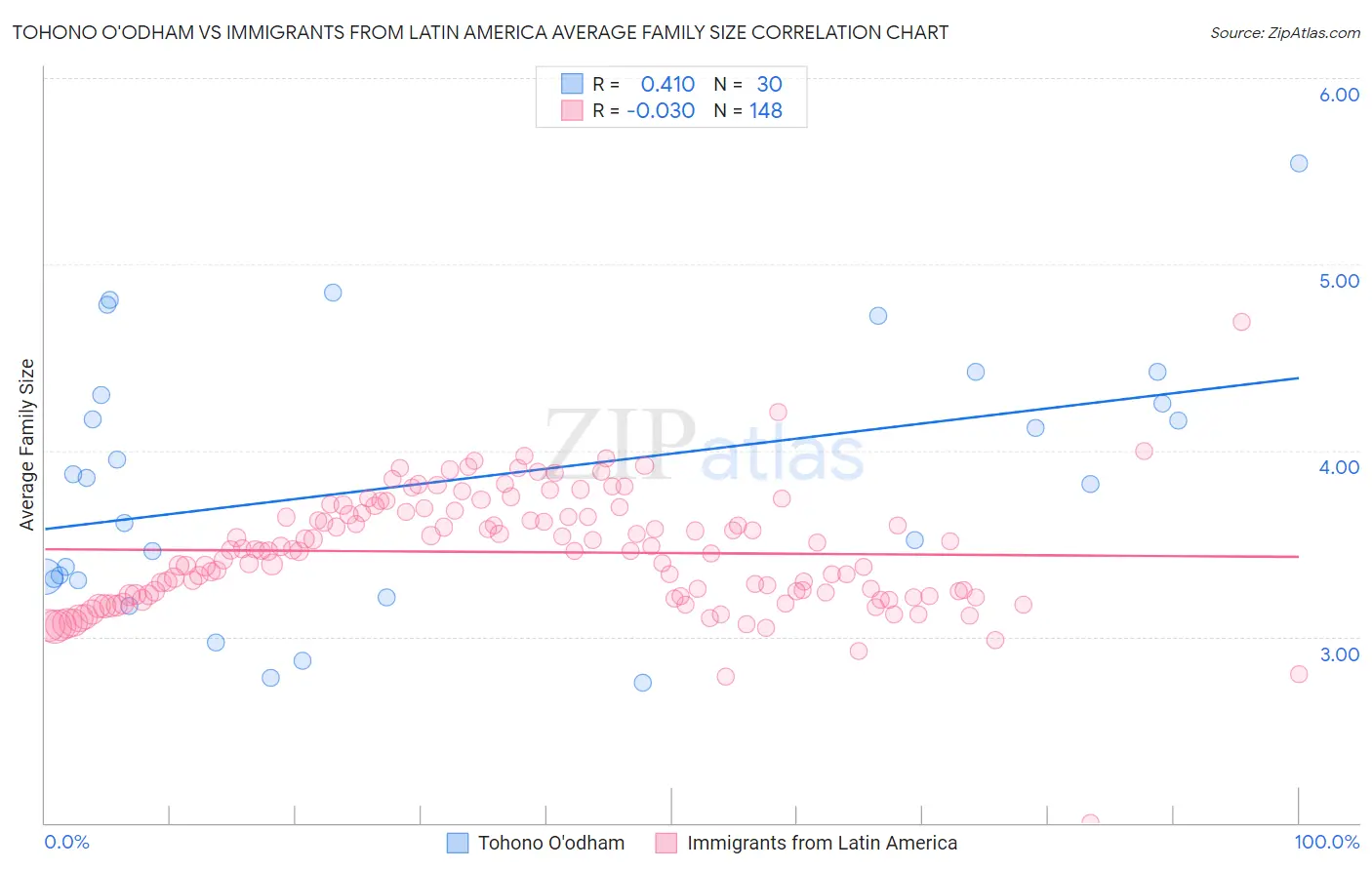Tohono O'odham vs Immigrants from Latin America Average Family Size
COMPARE
Tohono O'odham
Immigrants from Latin America
Average Family Size
Average Family Size Comparison
Tohono O'odham
Immigrants from Latin America
3.53
AVERAGE FAMILY SIZE
100.0/ 100
METRIC RATING
11th/ 347
METRIC RANK
3.42
AVERAGE FAMILY SIZE
100.0/ 100
METRIC RATING
28th/ 347
METRIC RANK
Tohono O'odham vs Immigrants from Latin America Average Family Size Correlation Chart
The statistical analysis conducted on geographies consisting of 58,718,905 people shows a moderate positive correlation between the proportion of Tohono O'odham and average family size in the United States with a correlation coefficient (R) of 0.410 and weighted average of 3.53. Similarly, the statistical analysis conducted on geographies consisting of 558,036,591 people shows no correlation between the proportion of Immigrants from Latin America and average family size in the United States with a correlation coefficient (R) of -0.030 and weighted average of 3.42, a difference of 3.2%.

Average Family Size Correlation Summary
| Measurement | Tohono O'odham | Immigrants from Latin America |
| Minimum | 2.75 | 2.00 |
| Maximum | 5.54 | 4.69 |
| Range | 2.79 | 2.69 |
| Mean | 3.83 | 3.45 |
| Median | 3.84 | 3.46 |
| Interquartile 25% (IQ1) | 3.31 | 3.22 |
| Interquartile 75% (IQ3) | 4.30 | 3.67 |
| Interquartile Range (IQR) | 0.99 | 0.45 |
| Standard Deviation (Sample) | 0.70 | 0.32 |
| Standard Deviation (Population) | 0.69 | 0.32 |
Demographics Similar to Tohono O'odham and Immigrants from Latin America by Average Family Size
In terms of average family size, the demographic groups most similar to Tohono O'odham are Immigrants from Mexico (3.52, a difference of 0.42%), Sioux (3.52, a difference of 0.50%), Immigrants from Central America (3.49, a difference of 1.1%), Tongan (3.49, a difference of 1.2%), and Ute (3.49, a difference of 1.2%). Similarly, the demographic groups most similar to Immigrants from Latin America are Nepalese (3.42, a difference of 0.090%), Mexican American Indian (3.43, a difference of 0.12%), Native Hawaiian (3.43, a difference of 0.13%), Yakama (3.45, a difference of 0.64%), and Native/Alaskan (3.45, a difference of 0.75%).
| Demographics | Rating | Rank | Average Family Size |
| Hopi | 100.0 /100 | #9 | Exceptional 3.60 |
| Spanish American Indians | 100.0 /100 | #10 | Exceptional 3.58 |
| Tohono O'odham | 100.0 /100 | #11 | Exceptional 3.53 |
| Immigrants | Mexico | 100.0 /100 | #12 | Exceptional 3.52 |
| Sioux | 100.0 /100 | #13 | Exceptional 3.52 |
| Immigrants | Central America | 100.0 /100 | #14 | Exceptional 3.49 |
| Tongans | 100.0 /100 | #15 | Exceptional 3.49 |
| Ute | 100.0 /100 | #16 | Exceptional 3.49 |
| Immigrants | El Salvador | 100.0 /100 | #17 | Exceptional 3.49 |
| Salvadorans | 100.0 /100 | #18 | Exceptional 3.48 |
| Mexicans | 100.0 /100 | #19 | Exceptional 3.48 |
| Cheyenne | 100.0 /100 | #20 | Exceptional 3.47 |
| Yuman | 100.0 /100 | #21 | Exceptional 3.47 |
| Apache | 100.0 /100 | #22 | Exceptional 3.46 |
| Immigrants | Fiji | 100.0 /100 | #23 | Exceptional 3.45 |
| Natives/Alaskans | 100.0 /100 | #24 | Exceptional 3.45 |
| Yakama | 100.0 /100 | #25 | Exceptional 3.45 |
| Native Hawaiians | 100.0 /100 | #26 | Exceptional 3.43 |
| Mexican American Indians | 100.0 /100 | #27 | Exceptional 3.43 |
| Immigrants | Latin America | 100.0 /100 | #28 | Exceptional 3.42 |
| Nepalese | 100.0 /100 | #29 | Exceptional 3.42 |